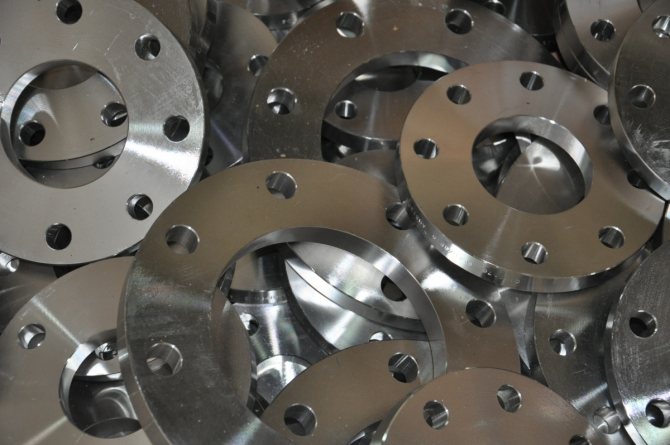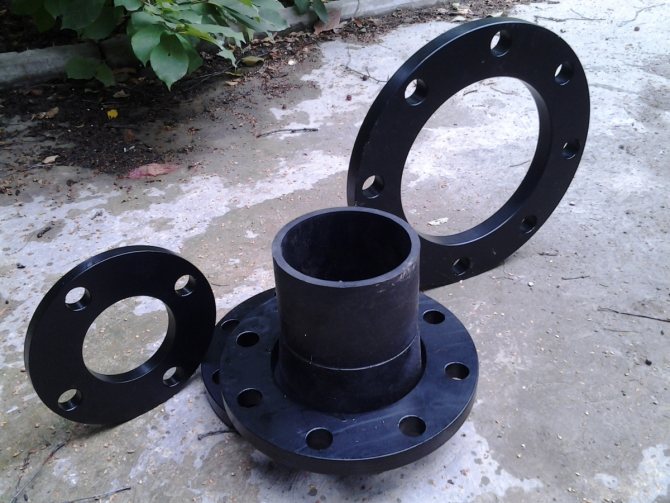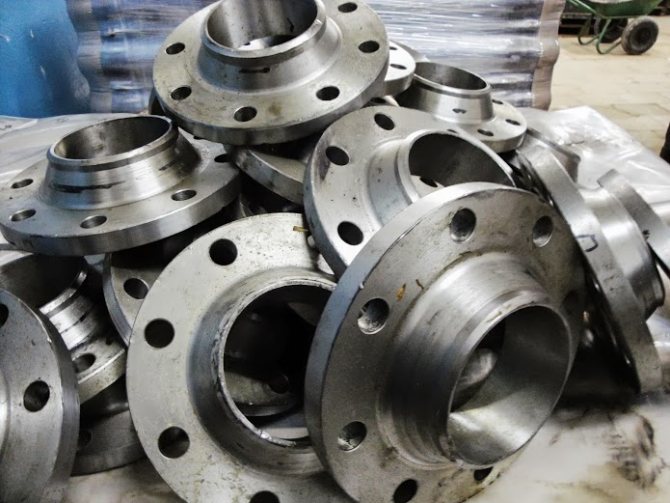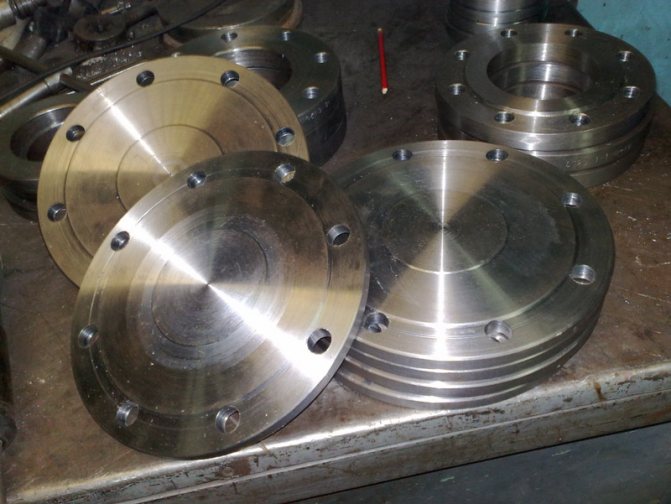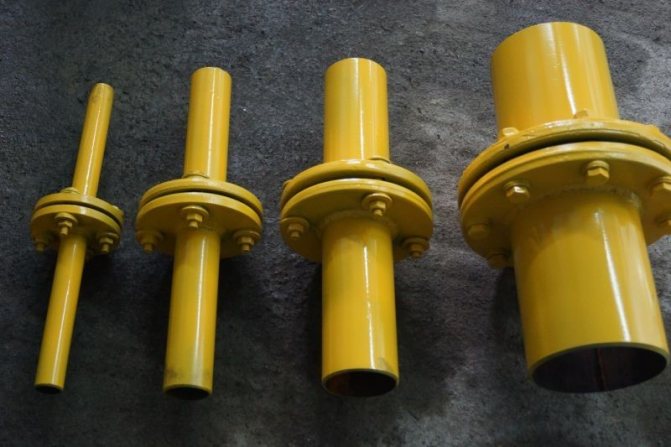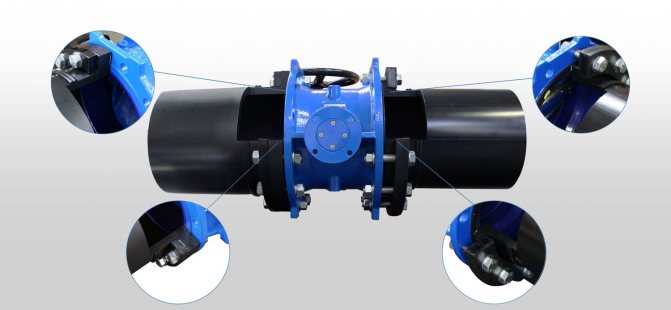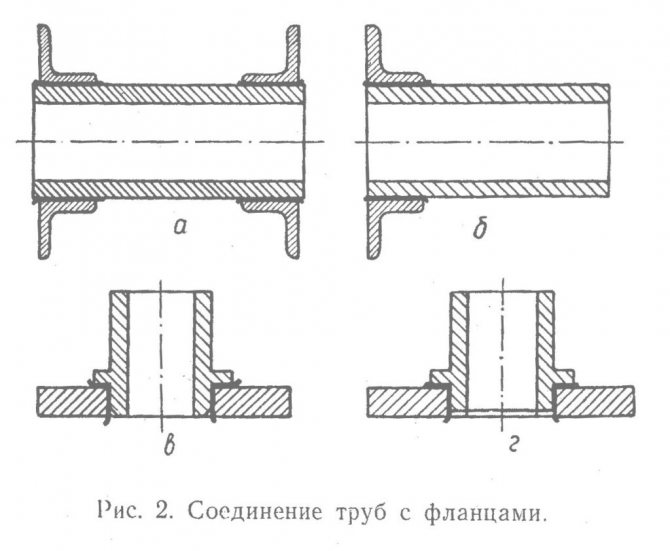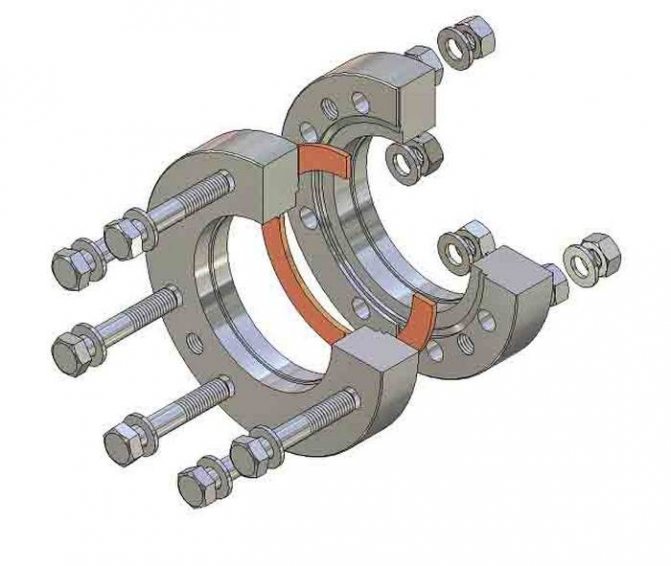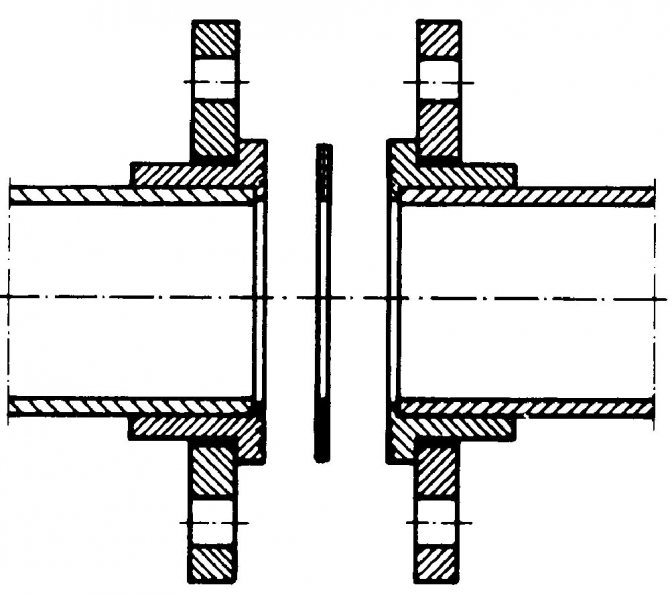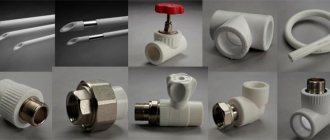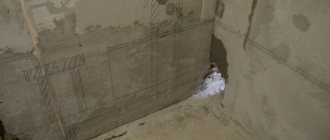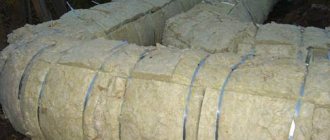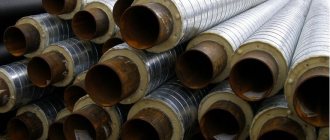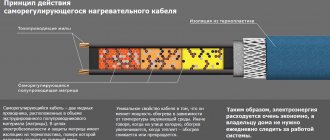Another classification
For some, special types of elements are made. What is a special flange? These are the same hardware, but in order to make some work convenient, their design is slightly modified. They can also be welded, loose, cast, threaded. Only on them are grooves cut or projections welded on. For their manufacture, first, special drawings are developed and molds are cast. Such hardware is made by order of enterprises.
From a distance, huge and long main pipelines (gas, water, oil, steam) seem to be solid and continuous lines. But it is worth getting closer, and the joints of the pipes become noticeable. This is where the answer to the question of what flanges is. They are different: round and square, steel flat welded or steel collar flanges. But all are very important to ensure the safety of the pipelines.
Flange manufacturing
Various grades of steel are used for manufacturing: 13XFA, 20 / 09G2S, 12X18H10T, 15X5 M and others. In addition, they can be steel or stainless. The technology used is different. Manufacturers use forging, stamping, casting. For each method, special equipment and forms are used. When releasing their products, manufacturers carefully check their quality. Applying special tests in their work, employees of the Quality Control Department check them for strength and reliability. Flanges are also tested for moisture resistance.
What it is? Since they are fasteners and are involved in joining metal parts that may come into contact with water, it is important that they do not corrode. That is why waterproof metal alloys are used.
Manufacturers often cover the flange surface with an additional protective layer.
Projection height
If you look at the drawing of a steel flange, then it has several parameters, including the height of the protrusion. It is designated by the letters H and B, it can be measured in all types of products, except for the one that has a lap joint. The following should be remembered:
- models with pressure class 150 and 300 will have a protrusion height of 1.6 mm;
- models with pressure class 400, 600,900,1500 and 2000 have a shoulder height of 6.4 mm.
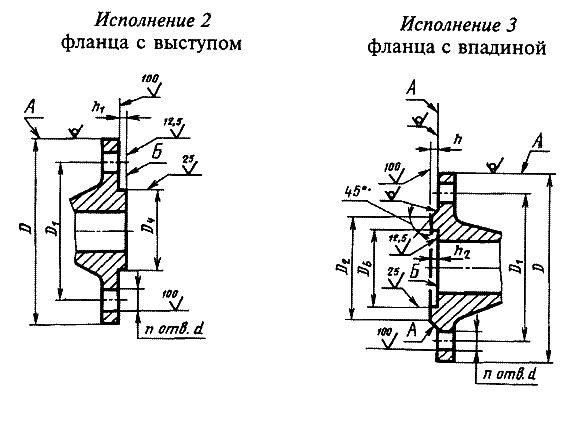
With ledge and depression
In the first case, suppliers and manufacturers of parts take into account the surface of the protrusion, in the second case, the surface of the protrusion is not included in the specified parameter. In part brochures, these figures may be quoted in inches, where 1.6 mm is 1/16 inch and 6.4 mm is ¼ inch.
Operating pressure
This is the pressure with which a liquid (gas, steam, etc.) is transported through the system. Consequently, the higher the working pressure in the system, the higher the strength characteristics it is necessary to choose fasteners. In turn, the required strength characteristics of the fasteners are ensured by the correct choice of material, heat treatment modes, etc. Thus, in the temperature range from -40 to + 400 ° C, and at pressures up to 100 kgf / cm2, it is recommended to use fasteners made of steel 35, while an increase in pressure up to 200 kgf / cm2 requires the use of fasteners made of steel 20X13.
Symbols to be aware of when choosing flanges
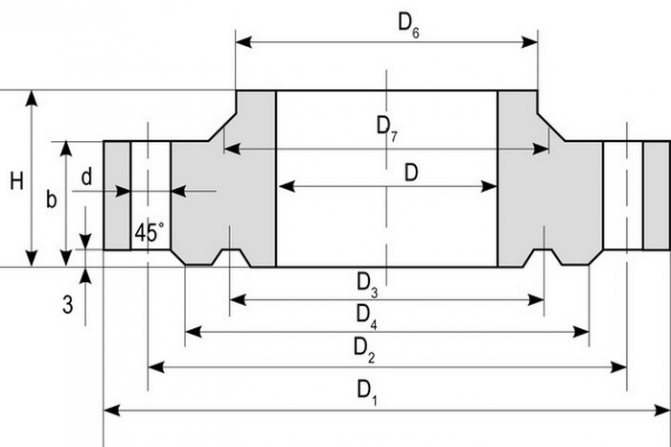

Since pipes and flanges have their own design features, you should pay attention to them when choosing fittings. To correctly interpret the designations on the flanges, you need to know the following terms:
- DN (nominal bore) - this designation indicates the internal diameter, for example, of pipes, flanges, valves, etc.
It's important to know! If the inner diameter of flat flanges is 100, 125, 150, then the abbreviation A, B, C is added to the size, which indicates the difference in the outer diameter.
- The row is the center distance between the mounting holes. There are two standard sizes for any weld flange - row "1" and row "2" (this is the default size, in the absence of designations).
- The nominal pressure is the pressure in the system, at which the full operability of the pipelines is ensured, without leaks and ruptures. Depending on the size and material of the flanges, the pressure ratings will vary.
Advice! When choosing, one should take into account not only the diameter of the pipes, but also the allowable pressure in the system. It should also be borne in mind that the dimensions of pressure can be indicated in MPa (Pa), Bar, Atm or kgf / cm2 (m2).
Geometry and specific gravity of products
An important parameter that determines the geometry is the nominal bore of the products. As already noted, it is denoted by the letters "DN" and has indicators from 10 to 200. This concerns the choice of the required part: when the user knows DN, all other dimensions are assigned to the flange automatically. For example, for a DN 50 model, the indentation height will be 57-59; DN 80 this figure is 89-91, and DN 100 - 108-110, where the first figure indicates the inner diameter of the pipe or branch pipe, and the second indicates the outer diameter.
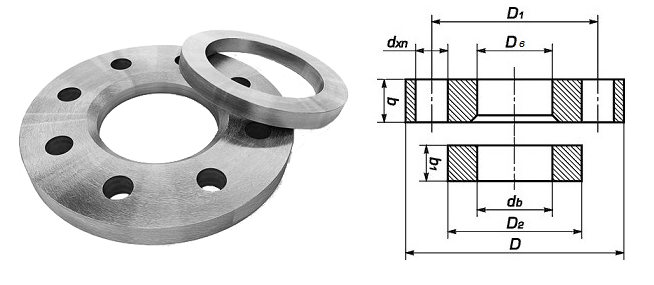

Flat flange drawing
Another important indicator is the weight of the flanges. It depends not only on volumes, sizes and height, but also on its geometry, material of manufacture. It is worth giving an example: a flange according to GOST 12820-80 with DN 100 of a flat type has a weight of 2.85 kg, while a flange of the same diameter, but a collar type according to GOST 12821-80, has a weight of 4.4 kg. This means that collar flanges are heavier than flat pieces.
Material of manufacture of parts of connections
The main element, the flange, is predominantly made from steel (carbon, low alloy, stainless) and cast iron (ductile and gray type). Less often used are polypropylene, titanium, aluminum, bronze, brass. The use of polypropylene has become widespread only in recent years. The installation is mainly performed for plastic pipes.
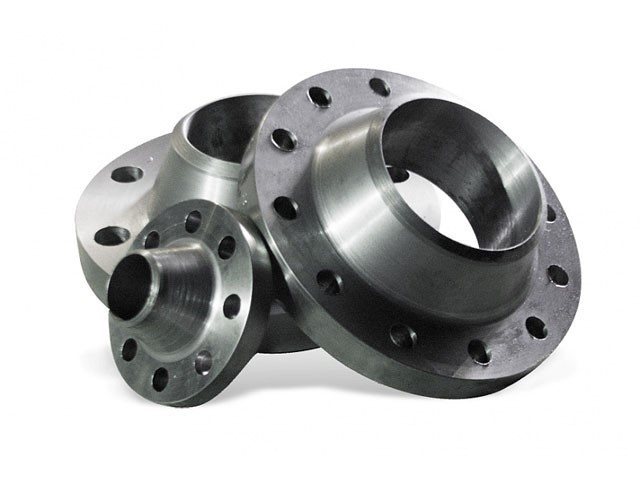

Requirements for the material of the product (brand) are determined by the temperature regime, pipeline pressure and other parameters. Tables of the dependence of the metal grade on pressure and permissible temperatures are established by standards in GOST. In the standard version, in the production of flanges, a material is used that is identical to the composition of the pipeline or places of installation of products.
Special requirements are imposed not only on the material for the manufacture of flanges, but also on the sealing elements of the connection. The gaskets ensure tightness. For their manufacture, technical rubber with various characteristics is used: resistant to acids, alkalis, oils, gasoline, high temperatures. The type of gasket and material is determined by the purpose of the pipeline and the characteristics of the connection. Less commonly used materials are: wound, fluoroplastic or asbestos cardboard.
What are flanges
They are usually used in pairs. In simple terms, it is a round or square fastener into which a pipe or other piping element is inserted. The next pipe is inserted into the other flange, after which the two fasteners are bolted together. For this, a large number of holes are provided along the outer perimeter of the part. Other types of products are put on the end of the pipe. The junction of the pipe and flange is welded. Thus, it is a connecting element for pipelines, tanks, vessels, shafts, instruments, etc. For it, you also need to select the correct flange fasteners (bolts, nuts, washers, studs), the type and strength of which all directly depend on the same pressure, temperature and type of the transported medium.
Tightening process and sequence of actions
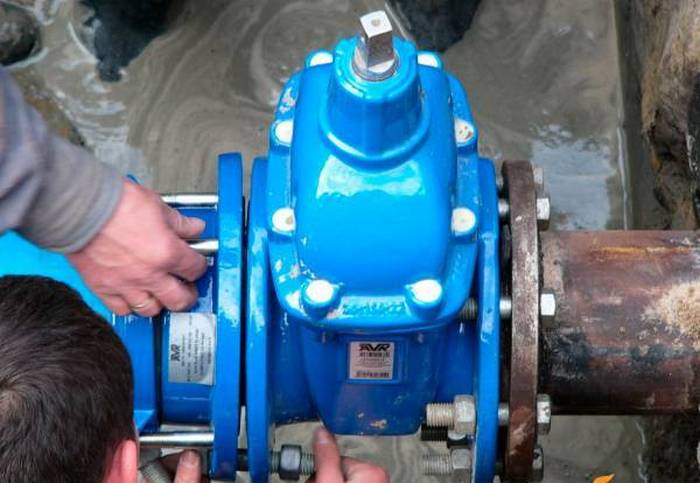

Once the flanges are welded and a gasket is installed between them, make sure it does not interfere with the installation of the tie bolts or studs.
To ensure uniform pipe tightening, all bolts are tightened to a small amount. Then the first bolt is tightened, and the second after it will be the opposite to it, etc. The tightening method is called "criss-cross" - this will ensure maximum uniformity of the gasket seal and prevent excessive stress on the pipes.
Insulating flange connections description, IFS purpose.
An insulating flange joint is a structure often used in pipelines, consisting of three flanges, between which a paronite gasket PON-B is used as an insulating sealant. The flanges are connected to each other using studs, which in turn are also isolated from the flange using fluoroplastic bushings. The insulating flange connection design also includes three screws for connecting electrical instruments.
An insulating flange joint is a pipeline element designed to protect the pipeline from stray currents - the so-called electrochemical corrosion. The problem of electrochemical corrosion is acute in the operation of pipelines laid underground. Stray currents, penetrating into pipes that do not have reliable insulation, are safe at the entrance, but create a dangerous anode zone at the exit, in which the metal is gradually destroyed under the influence of an electric current. Subsequently, cracks can appear in the system, which can lead to leaks and accidents in the pipeline system.
In the production of IFS, slates from steel 09g2s, gaskets and bushings made of fluoroplastic, hardware from steel 40x (according to GOST 12816) are used.
Cases when the IFS is installed:
• at the branches of pipeline sections from the main pipeline;
• near objects of probable sources of stray currents, such objects can be power substations, tram depots, repair bases;
• when installing the pipeline if its parts are made of different metals;
• to disconnect an insulated pipeline from various potentially hazardous structures or at the entrance to such facilities;
• at the outlet of the pipeline system from the supplier's territory and at its entrance to the consumer's territory;
• on vertical elevated sections of inlets and outlets of gas distribution points and gas distribution stations.
An insulating flange connection is made of two flanges manufactured in accordance with GOST 12820-80 or GOST 12821-80.
In the design in which flanges according to GOST 12820-80 are used, to ensure non-separable assembly of connections, when assembling the connections, steel pipes are welded to the flanges. This allows welding of joints without fear of overheating, loss of tightness or loss of electrical insulating properties.
Features and characteristics
The main characteristic of flange mounts is their design features. In Russia and in the CIS countries, the following standards are most popular:
- GOST 12820-80. It defines the design differences of the flat type of welded flanges.
- GOST 12821-80. It defines the design characteristics of butt-weld flanges.
- GOST 12822-80. This document determines the structural characteristics of steel flanges free on the welded disk.
Fixtures that belong to these three main groups are designed to interface directly to the network and equipment. The installation conditions for any of the presented mechanisms are different.
Flat welded steel parts. During installation activities, such an element is "pushed" onto the pipe, and after that it is welded with a pair of welding seams around it.
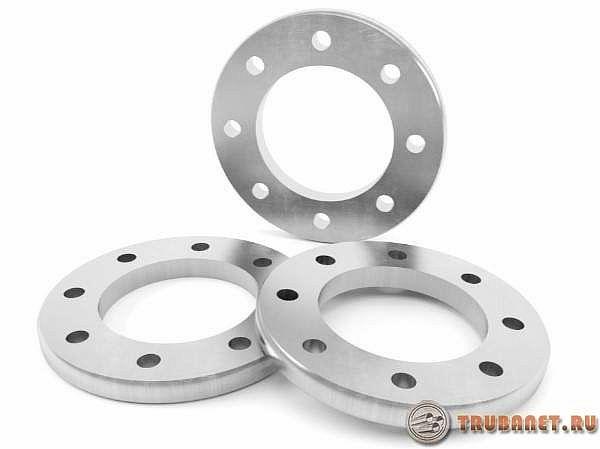

Butt welded steel mechanism. The installation of this steel part, if compared with the first option, necessitates the presence of only one welded seam - the connection.
With such actions, the end part of the pipe and the "collar" of the connection mechanism are fastened end-to-end. This greatly simplifies the process of fastening the part and reduces the time spent on installation.
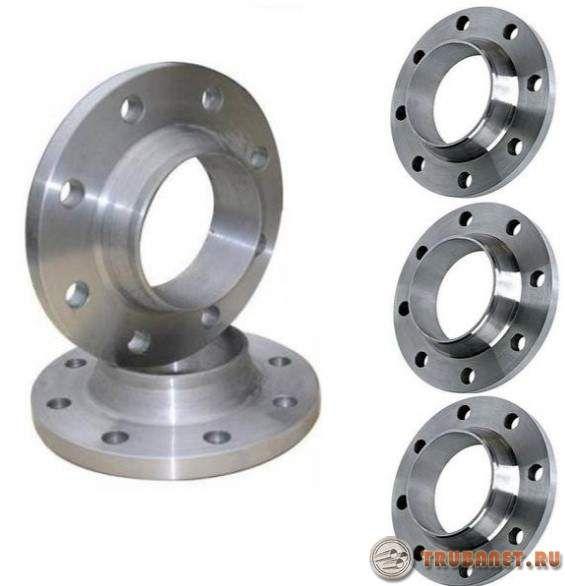

Loose steel structure on a welded ring. It includes the main part and the ring, and they, in turn, must have the same conditional volume and pressure.
If we draw a parallel with the previously indicated options, then in this mechanism the ease of installation is at a higher level, because the disk itself is welded onto the pipes, and the flange is left in a free location.
Thanks to this, the connection of bolt holes on free-spaced parts and on a similar mechanism on the valve is carried out without difficulty, even in a place of difficult access. It is also not necessary to turn the pipe with this connection.
The positive aspects of their use include the fact that when selecting for a stainless steel pipe, you can put a stainless steel ring, and a flange structure made of carbon steel.
Other classifications are used in the world, for example:
- DIN are the German standards of the standard, they are valid in European countries;
- ANSI / ASME is an American standard and is valid in Japan, USA and Australia.
These standards are translated in special tables, where there is a clear indication of which standard determines the characteristics of a particular product.
Flange sealing faces
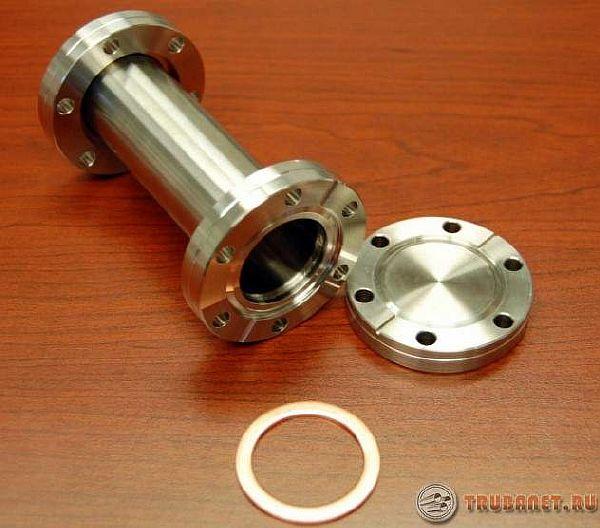

As already mentioned, these products for steel pipes are manufactured in accordance with GOST standards. And such reinforcement fasteners are made with sealing surfaces in the following design:
- Plane, denoted - A.
- Hollow. Designated - F.
- Groove. Its designation is D and M.
- For lens gaskets. The designations for this option are K.
- Protrusion for connection. With the designation V.
- Protrusion. It is designated - E.
- Spike. This type is designated C and
- For oval section gaskets. The designation of this species is J.
Valve flanges must be produced with sealing surfaces of type A, B, D, F, J, K, M. Other variants of valve flange sealing surfaces are allowed only at the request of customers.
Flanges with sealing surfaces A, B, C, D, E,, F are used with joints that are sealed with such gaskets:
- serrated;
- metal;
- graphite;
- metallographite.
Flanges are manufactured in accordance with the requirements that ensure the maintenance of geometric dimensions and mechanical characteristics.
For example, flat flanges can be produced by welding, if the conditions for welding the seam are maintained during operation, this must be done along the entire length of the section on the device. The quality level of such seams is recommended to be checked ultrasonically.
Video
Steel butt-welded products are preferable to be made from forgings, stampings, or banding blanks. For such products, in no case should you take sheet metal and use the turning method.
As a rule, the manufacturing method is determined by the manufacturer, in the event that the customer has not additionally discussed this during the application.
Round and square views
By type of construction, the data characterize:
- The value of the conditional passage, it is measured in millimeters and denoted by DU.
- The value of the conditional pressure. It is measured in kgf / cm2.
- Material used as raw material.
- Directly execution. In this situation, numbers from one to nine are used, they indicate the desired type of surface to be installed under the gasket.
The technological characteristics of steel flanged joints on pipes are directly related to the technological processes and workpieces that are taken for work.
Flanges by type of production are round and square.At the moment, the number of fittings for pipelines, where square-shaped products are needed, is not so much. But, despite this, such mechanisms have not lost their relevance.
For these reasons, for pressure indicators that do not exceed 40 kgf / cm2 in relation to GOST 12815-80, not only round-shaped mechanisms are provided, but also square-shaped types.
Video
When making an application for such a product for steel pipes, you should know that its volume is directly dependent on the conditional pressure. For higher pressure thresholds on the pipe, structures with large volumes must be installed.
The pressure they can withstand
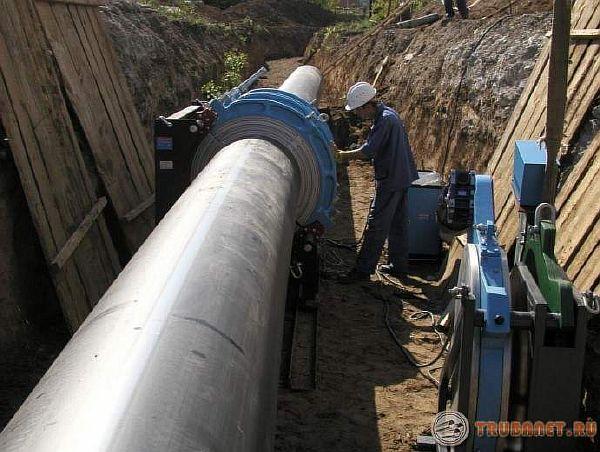

This is a very significant indicator carried by this mechanism. The values for these parameters depend on the geometric standard sizes of the product. This is also influenced by the variant of the sealing surfaces.
Weldable flat steel products (GOST 12820-80) and loose steel parts on the welded disk (GOST 12822-80) carry loads up to 25 kgf / cm2. And the options welded end-to-end (GOST 12821-80) carry the influence even up to 200 kgf / cm2.
The value in such situations is shown in various representations, these are:
- Pa;
- MPa;
- atm;
- kgf / cm2 and others.
But, releasing products of this line, the main measuring parameter is kgf / cm2.
Insulating flange connections on the gas pipeline
Central warehouse store and assembly area
pos. Ridge, st. Sputnik / st. Kurgan, 330-37-01, 246-53-78
LLC "Stroykomplekt" is a certified manufacturer of IFS (insulating connection of gas pipelines, insulating flange connection). The certificate of conformity No. С-RU.AE56.B.00987 TP 0681219 was issued by the certification body. Valid from 06/06/2011 to 05/06/2016. ...
A special order is possible for the manufacture of components and IFS (insulating flange connection, insulating connection of gas pipelines) with DN up to 300.
IFS (insulating flange joint), insulating joint of gas pipelines) is a firmly tight connection of two sections of the pipeline, which, by means of an electrically insulating gasket and bushings, prevents the passage of electric current along the pipeline. IFS (insulating flange connection, insulating connection of gas pipelines) consists of three flanges. A paronite gasket PON-B was used between them as a sealant-insulator. The connection of the flanges is provided by pins, which are isolated from the flange by fluoroplastic bushings. Three screws are provided for the connection of electrical measuring instruments in the IFS design (insulating flange connection, insulating connection of gas pipelines).
Technical characteristics:
Nominal pressure of the medium (PN) 10, 16, 25 kgf / cm2 Temperature of the medium: from -30 to 250 ° С Resistance at a voltage of 1 kV, not less than 5 MΩ
Complies with GOST 12816-80 Certificate No. ROSS RU.AYU96.B03259 dated 12.04.05 License No. AYu96.B00415 dated 07.05.01
Fig. 1 Insulating flange connection
Technical description:
IFS (insulating joint of gas pipelines, insulating flange joint) is a firmly tight connection of two sections of the pipeline, which, by means of an electrically insulating gasket and bushings, prevents the passage of electric current along the pipeline. The design of the IFS (insulating connection of gas pipelines, insulating flange connection) is shown in Fig. 1. IFS (insulating connection of gas pipelines, insulating flange connection) consists of three flanges (pos. 1 and 3). A paronite gasket PON-B (item 5) is used as a seal between them. The connection of the flanges (pos. 1 and 3) is secured by a stud (pos. 4), which is isolated from the flange (pos. 1) by a fluoroplastic bushing (pos. 2). To connect electrical measuring instruments in the IFS design (insulating connection of gas pipelines, insulating flange connection), three screws are provided (item 6).
Flange pressure classes
Parts manufactured according to Asme (Asni) standards are always characterized by a number of parameters. One of these parameters is the nominal pressure. In this case, the diameter of the product must correspond to its pressure in accordance with the established samples. The nominal diameter is indicated by a combination of the letters "ДУ" or "DN", after which there is a number that characterizes the diameter itself. Nominal pressure is measured in "RU" or "PN".
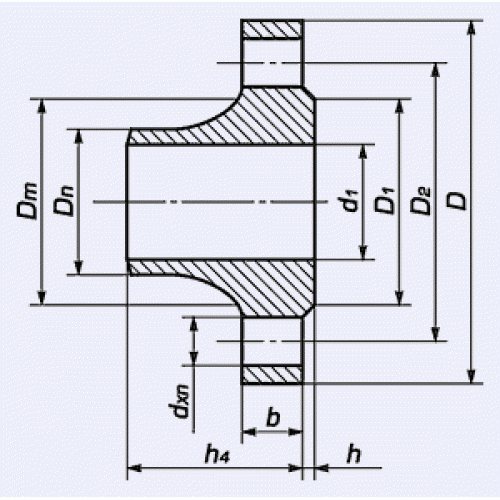

Flange drawing with various designations
The pressure classes of the American system correspond to the conversion to MPa:
- 150 psi - 1.03 MPa;
- 300 psi - 2.07 MPa;
- 400 psi - 2.76 MPa;
- 600 psi - 4.14 MPa;
- 900 psi - 6.21 MPa;
- 1500 psi - 10.34 MPa;
- 2000 psi - 13.79 MPa;
- 3000 psi - 20.68 MPa.
Translated from MPa, each class will indicate the flange pressure in kgf / cm². The pressure class determines where the selected part will be used.
Flange varieties
On the official website of our company, a virtual catalog is presented, in which all sold fittings are placed according to thematic sections. In it, a separate place is allocated to flanges, which differ from each other not only in modification, but also in the following parameters:
- by the method of installation;
- by scope of application;
- on the materials that were used in their manufacture;
- by operating parameters.
Flat and collar flanges are available to our customers today. They are actively used by business entities specializing in the production and extraction of minerals.
Features of collar flanges
In the process of manufacturing collar flanges, manufacturers use high-strength steel of various markings as the main raw material. Finished products are capable of withstanding a pressure of 1-10 MPa and can be operated at various operating temperatures, therefore, they are classified as follows:
- steel grade No. 20 and 25 - the flange will perform the functions assigned to it at temperatures up to - 30 degrees;
- structural steel grades - flanges can be operated at extremely low temperatures up to - 70 degrees.
The design features of collar flanges include the presence of truncated protrusions on their surface. The function of this element is to provide a hermetic pipe connection.
Technical capabilities of flat flanges
Flat flanges are manufactured in a production environment with high-tech equipment and modern technical standards. Finished products fully comply with state norms and standards, and are sold for sale along with accompanying documentation and relevant certificates. The main purpose of flat flanges is to provide detachable pipe connections during the installation of pipelines and control units for shut-off valves and systems. It should be noted that, despite the possibility of quick dismantling of such flanges, their use guarantees the most tight connection for engineering communications. These fittings are capable of performing their functions for many decades at a wide temperature range: from + 300 to - 70 degrees. Visitors to the website of the TK Engineering company have access to various modifications of flat steel flanges, which are made of the following types:
- heat resistant;
- stainless;
- alloyed, etc.
We also offer:
Flat steel flanges
Flange connection components and standardization
The flange connection is installed using fasteners and welding. The connection kit has several components:
- Flange - a metal part of a flat profile with symmetrically placed holes for mounting.
- Fasteners.
- Gaskets - joint seals.
Flange fasteners consist of several elements - studs or bolts, washers (engravers) and nuts. Fasteners are made from various materials and are used for a specific type of flange, taking into account the hole diameter, expressed in millimeters. Threaded connections have standard thread pitch parameters. Metric type is expressed in millimeters, inch is defined in inches. Requirements for the fastening of the connection are established by regulatory documents and state standards.
When installing flanges, fasteners are used:
- Bolts - a rod with a threaded thread on one part of the part and a multi-faceted head on the other. The standard parameter is the length of the bolt, determined in millimeters and the metric thread.
- A hairpin is a rod-shaped part with threads at both ends. One threaded connection is installed in the main structure, the second part is fastened with a nut. In some cases, installation is carried out by installing nuts on both ends of the stud.
- Nuts - polyhedron with a hole and a threaded notch inside. It is used for tightening the flanges by means of a bolt. Used simultaneously with the installation of washers.
- Washer is a flat round piece with a hole that fits under the nut. Does not allow the nut to spoil the coating of the flange or shut-off valves, provides a stable position of the fasteners, the elimination of distortions in the position and maximum clamping. Washers of the pressure, end, lock type are used.
- The engraver is a round cut washer of a square profile, made of hardened steel. The engraver is installed between the nut and flat washer and is designed to protect against loosening of the nut.
Parts of the flange connection kit have unified parameters that meet national and international standards. In our country, GOST standardization is used, DIN is valid in Europe, for a number of countries (Japan, USA and others) the American ANSI / ASME system is applicable.
A clear classification of flanges allows the use of connection elements in different countries without additional adjustment of parameters. Differences in the classification of designations in the standards are easily eliminated using translation tables.
Along with standard products, there is a need for flanges with non-standard diameters and locations for fasteners. Custom-made parts may have tabs, additional holes or grooves. Products are manufactured according to individual orders and drawings, allowing to solve narrow technological problems.
What are they made of?
Flanges are made of steel. Depending on the working pressure, temperature and type of the transported medium (steam, gas, oil, water), they are produced either from a special alloy or from conventional grades of carbon and stainless steel.
Main types:
- the most common are conventional flat weld flanges;
- steel collar flanges are more durable and comfortable;
- for installation in hard-to-reach places, a free flange on the welded ring is most often used;
- non-standard flanges, which are made according to individual drawings for a specific order.
Consider the most popular product options.
Flange types
So, a flange is, first of all, a hardware. Depending on the application, these parts can be flat, collar, free. The design is not much different. The collar flanges have a small cone-like projection. It is often called a collar. This type of flange is used when parts need to be butt welded. This protrusion helps to tightly connect the pipe fittings together. They are also necessary when pipelines are supplied to tanks or other technical equipment. The main advantage of these flanges is that they can be used several times.These hardware are made of durable materials, and this allows them to be used in work where the temperature ranges from -253 to +600 degrees Celsius.
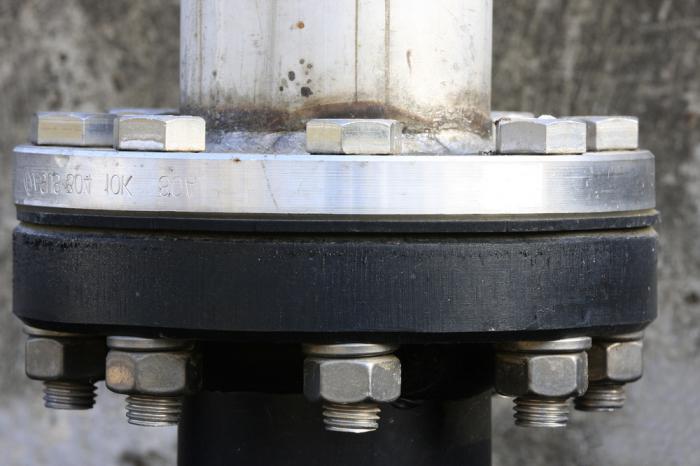

What is a flat flange? It is a hardware that resembles a flat disc with holes. It is used when you need to connect parts of fittings, shafts, vessels, pipelines, devices and the like. With this element, you can tightly fasten parts of the pipelines.
Loose flange - what is it? This view is not much different from the ones listed above. It consists of two parts: a regular flange and a ring
It is important that they are made of the same material and have the same diameter and pressure. They are used where the work is most difficult, where installation is difficult.
Due to the two parts, the connection will be tight and strong. First, a conventional flange is connected (it is welded), and then the other ring can then be safely turned during operation.
Purpose and scope
Flange connections can be installed on pipelines with a diameter of more than 32 mm. In this way, branched systems are mounted at industrial and chemical enterprises, in the gas and oil industry, distribution networks of housing and communal services. For laying intra-house pipelines, this type of connection is rarely used.
Flange joints are needed in order to:
- connect pipes to each other or to equipment made of dissimilar materials;
- install shut-off and control valves;
- clean pipelines;
- embed measuring instruments;
- cut off the pipe section for repair.
How is a flanged connection made?
When it is necessary to connect two parts of the pipeline, welding of a steel flange to the pipe is used. Such a fixation is called a flange connection and in the future it makes it possible to disassemble the pipeline in order to carry out repairs. To understand how the assembly takes place, you need to consider the process in detail:
- To join two elements, flat parts are used that have a hole in the center where the end of the pipe is inserted.
- There are holes along the perimeter of the ring - fasteners are inserted into them: bolts or studs with nuts.
- The connection will be detachable so that it is sealed using gaskets. A flange connection is designed to join two pipes or connect a pipe to a container equipped with a flanged inlet pipe.
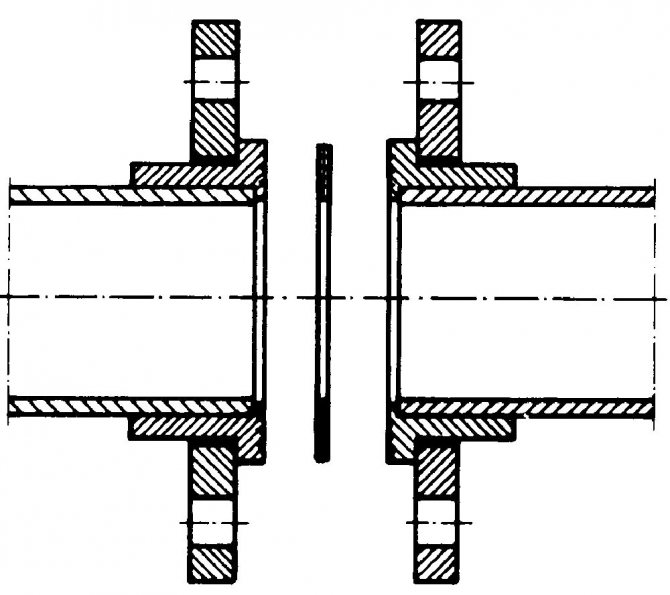

Illustrative example of a flange connection
The flange can be made with your own hands - such a detail is perfect for a sharpener for a machine for sharpening objects.
Compound Manufacturing Tools
To independently make the connection of two pipe parts, you need to prepare tools. Basically, this is equipment designed for tightening bolted joints around the circumference of the flanges:
- manual key;
- spanner key;
- pneumatic impact wrench;
- hydraulic torque wrench;
- bolt tensioner hydraulic type.
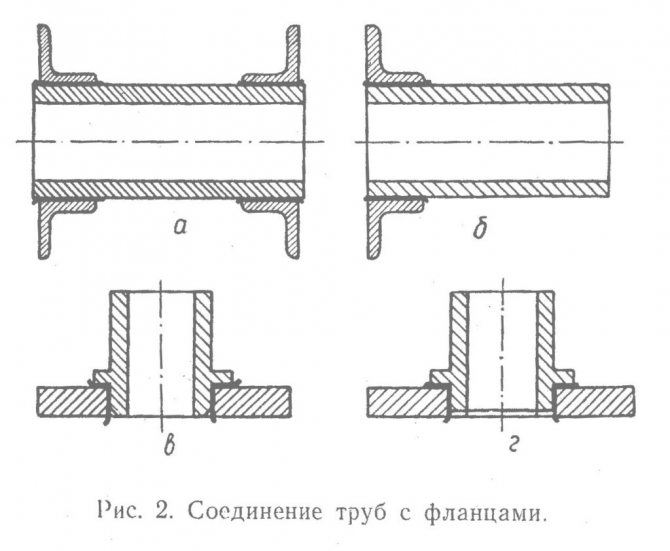

Docking on pipes
In addition, a special lubricant is required, which is applied to both surfaces to avoid friction between parts and ensure lightness of the torque. The sequence of work is simple: first, tighten the first bolt, then proceed to tighten the one that is diagonally 180 degrees from the first. Next, they go to the bolt located at an angle of 90 degrees from the second, and from it to the opposite one.
Tips from the masters
There are a number of useful recommendations from professional craftsmen who will help you cope with a flange connection the first time:
- If the parts have 4 holes, then the bolts must be tightened crosswise.
- The surface of the structure must be degreased and checked for corrosion and rust.
- It is recommended to use only new gaskets, and they must be installed strictly in the center.
- The tightening torque of the bolts must be uniform - this is the only way to ensure a reliable and tight flange connection.
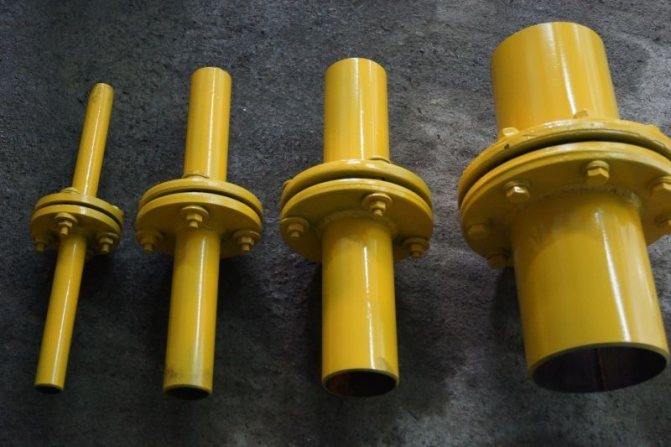

Connected pipes with flanges
In order to remove the flange in the future, special machines are used that help to bore it and loosen the bolts. It is difficult to remove parts manually, therefore pneumatic tools are used.
Connecting pipes with flanges is a convenient and reliable way of joining two parts. It helps in the future to carry out the repair of the pipeline by removing the connecting elements, while welding will not allow this procedure to be carried out. It is selected in exact accordance with the working conditions, temperature and pipe diameter.
Flange connection functions and features
What is a pipe flange? This is a flat steel plate of an annular (less often square or rectangular) shape. In the middle there is a hole on it where the end section of the pipe is inserted. The edges of the plate are equipped with several holes located at the same distance from each other: bolts or pins are threaded through them, and clamped with nuts.
Flanged pipe connections are a good alternative to welding and couplings, with the possibility of quick assembly and disassembly. The installation is accompanied by welding of the end part and the through-flange passage to each other. Further, the two plates are pulled together with each other using keys of the appropriate size. For large flanges, pipe arms are required when tightening.
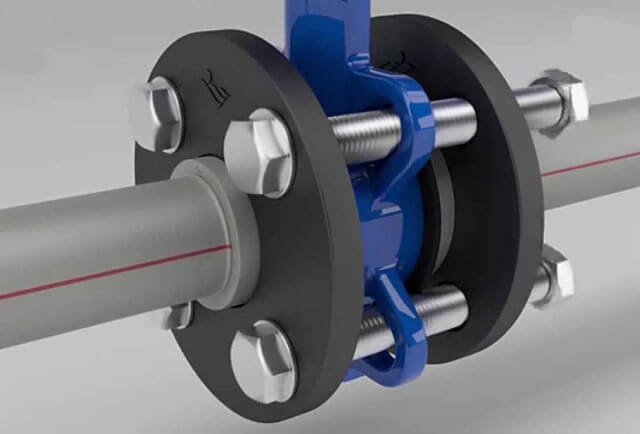

To make the docking tight, rubber or fluoroplastic sealing gaskets are used. In addition, if there is a need to overlap certain sections of the pipeline for repairs, it is envisaged to use special plugs, called seals. In this way, pipelines can be connected to various devices and technological tanks: these are mainly heat exchangers. For this, the end of the pipe is equipped with a welded flange that is connected to the intake pipe of the unit.
Flanges by type of application are divided into the following types:
- Separate sections of pipelines joining each other. Designed for a pressure of 0.1 - 20 MPa (GOST # 12815).
- Providing the possibility of joining pipelines with equipment and containers (GOST # 28759).
To calculate flange connections, there is a special literature with corresponding tables.
What the part is made of
In industry, steel flanges are used, but the steel from which the part is made also varies. The marking of the steel flanges will determine in what conditions it is best to use a given part:
- Steel 20 is the most used raw material. This is carbon steel, parts made of it are used to assemble fittings on highways, where the external temperature is not lower than –40 degrees, and the internal indicators are not higher than +475 degrees.
- Steel 09g2s - steel from alloys of nickel, chromium and molybdenum, intended for welding. Products made of this material can be used at an external temperature of –70 degrees.
- 12Х18Н10Т - cryogenic steel. Parts made of this material can be used in aggressive environments, for example, with alkalis and acids. The permissible temperature is from - 196 degrees to +350 degrees.
- 10Х17Н13М2Т - corrosion-resistant ordinary steel. Fasteners from it are used in particularly extreme conditions, because it remains resistant to stress corrosion. Working temperatures from -196 to +600 degrees.
- 15Х5М - low-alloy heat-resistant steel. Such products have high resistance to oxidation at temperatures of + 600-650 degrees.
These brands are the most used, but besides them, manufacturers use other raw materials.There are polypropylene models - they are designed for joining polypropylene pipes with metal valves. The operating temperature of such a material is much lower - +80 degrees. A collar for a flange can be sold to them in a set - a special part for creating a flange connection made of polypropylene.
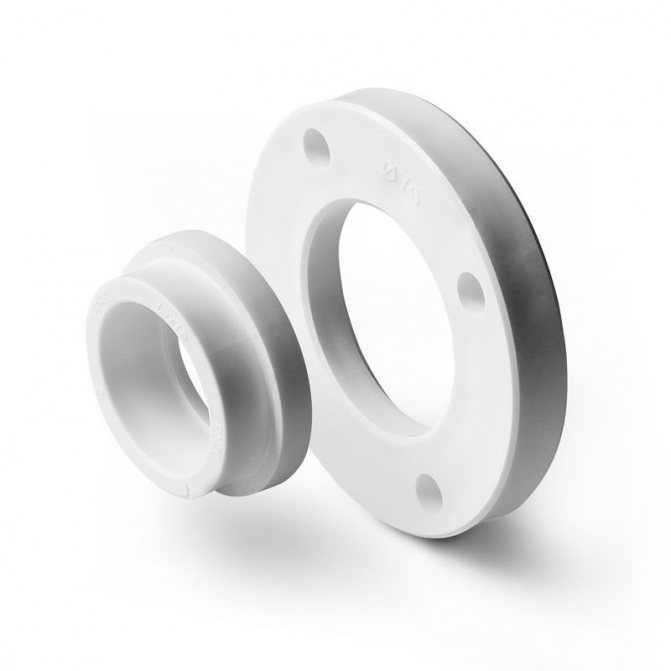

Polypropylene flange
In addition to steel and propylene, two types of cast iron are used - malleable and gray. Parts made of ductile iron are used at operating temperatures from -30 to +400 degrees, and from gray cast iron - at temperatures from -15 to +300 degrees.
Flange design specifics
What is a flanged pipe connection? In addition to the above connecting plates, the flange fasteners include a bolt (optionally a stud), a nut and a washer. As follows from the regulatory requirements (GOST No. 12816), pipelines can be equipped with bolts where the working medium has a pressure not exceeding 25 MPa. If this parameter is exceeded, it is recommended to use a steel bar-shaped mounting stud with threads on both ends. Stud connections are considered to be an order of magnitude stronger than in the case of using bolts.
Installation of flange connections on steel pipelines with a pressure above 100 MPa is carried out with studs made of steel No. 35. If the pressure is below 100 MPa, studs made of 20 steel will do. Flange washers are plates that are placed under a nut or bolt to increase their footprint. Usually they are made of steel. For flange connections for bolts, studs and washers, strength classes 8.8, 6.6 and 5.6 are allowed.
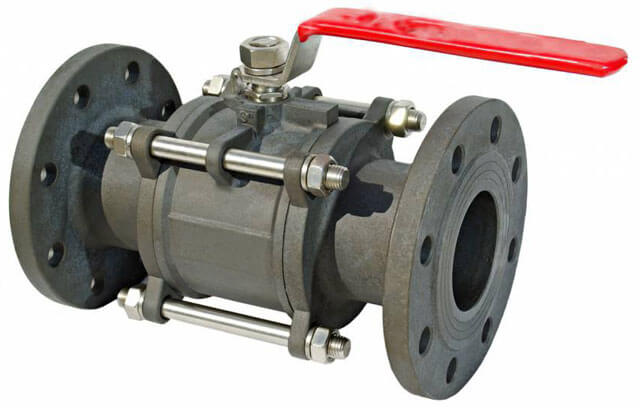

As for pipelines for transporting aggressive liquid substances, it will be necessary to install a special protective casing. It has the form of a cover, for the manufacture of which hydrophobic textiles, sheet steel or heat-resistant polymers are used: they keep the working fluid from splashing in the event of a flange connection depressurizing.
The diameters of the protective covers can be from 15 to 1200 mm. The most popular in this regard are fluoroplastic products that can comfortably tolerate temperatures from -200 to +230 degrees, without deforming for a long time. In addition, such casings are light enough, so there is no additional load on the line. On sale are presented in a disassembled form, for assembly at the site of operation, a corresponding diagram is attached.
Insulating flange connections
Thus, it does not simultaneously absorb moisture and avoids the passage of electric current through the pipeline. Sometimes gaskets are also made of fluoroplastic or vinyl plastic. The IFS also contains tie rods, polyamide bushings, washers and nuts. Thanks to these hardware, the flanges are pulled together and fixed in this position. Order only our production of flanges.
In general, an insulating flange connection is a strong attachment of two pipeline elements. An electrical insulating gasket plays an important role in it, which makes it possible to exclude the ingress of electric current into the pipeline. On average, the resistance of one insulating flange connection is at least 1000 ohms.
Tool required for mounting flanges and connecting them
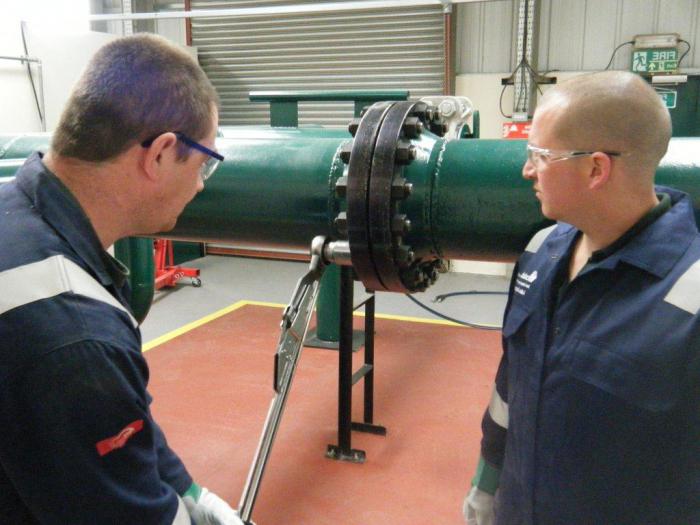

Installation of flanges for steel pipelines is carried out with the following set of tools:
- Grinder with a circle for stripping and cutting;
- Welding machine of the required power;
- Perforator;
- A set of spanners for tightening pipes. The best option would be a torque wrench or air impact wrench.
Important! In addition to the tool, consumables are required: drills, brushes, lubricants and paints and varnishes, crowns, etc. It all depends on the installation conditions, the complexity of the structure and the hazard during work.
There is no practical application of the flanged type of pipe connection in everyday life, this technology is used at enterprises and factories. In this regard, all structural units are rigorously tested in accordance with all regulations.
Despite the ease of installation of flange connections on piping systems, installation work should only be carried out by specially trained teams of mechanics. And in systems with increased danger (gas pipelines, water pipelines and for other pipelines with high pressure), the entire installation or repair process necessarily takes place under the supervision of an engineer.

